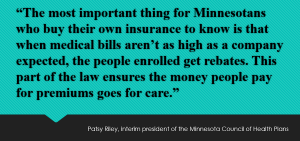Volatility continued for people who buy their own insurance; some to receive rebates
The Minnesota Council of Health Plans announced today its member companies paid $27.7 billion in medical bills for more than 5.5 million people in 2018. Council member insurers help Minnesotans in every county across the state pay for the care they need, no matter how they get their insurance.
In aggregate across all ways people get insurance, and in all locations, per person medical bills were up 3 percent on average over the previous year. Insurers collected $31 billion in premium revenue and after paying all expenses, ended the year with an operating gain of 1.6 percent of revenue, or $500 million.
Reinsurance paid high medical bills for Minnesotans who bought their own insurance
Minnesota’s premium security program, also known as reinsurance, helped pay high medical bills so the expenses weren’t added to people’s premiums. The help from the state meant monthly premiums in 2018 and 2019 were 20 percent lower on average. In fact, with the help of reinsurance Minnesota’s premiums in 2019 are the lowest in the country and enrollment from March 2018 to March 2019 remained steady.
While premiums decreased, medical bills did not. Monthly medical bills for these Minnesotans increased 8 percent per person over 2017. In all, these Minnesotans paid $867 million in premiums and had medical bills that reached $686 million. Since 2014, enrollment, premiums and medical bills have been difficult to predict. Between 2014 and 2018, total expenses have surpassed revenue by $395 million, a five-year average margin of -7 percent of premium revenue.
Two health insurers expect to send rebates to people who bought policies where medical bills weren’t as high as predicted when the rates were approved in 2017. Setting accurate premiums for these Minnesotans continued to be difficult as margins averaged 23 percent of premium revenue industry wide.
“The most important thing for Minnesotans to know is that when medical bills aren’t as high as a company expected, the people enrolled get rebates. This part of the law ensures the money people pay for premiums goes for care,” said Patsy Riley, interim president of the Minnesota Council of Health Plans.